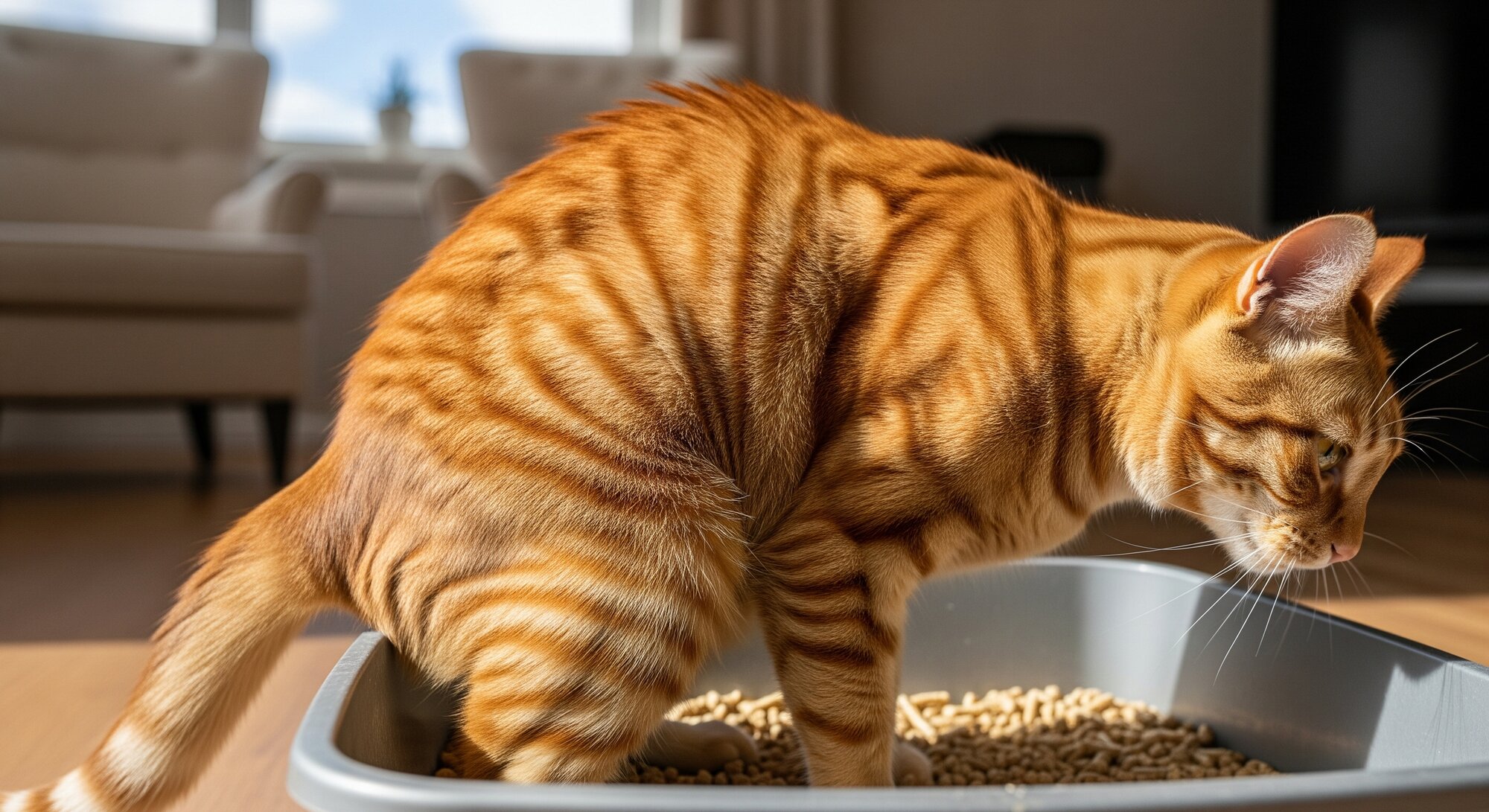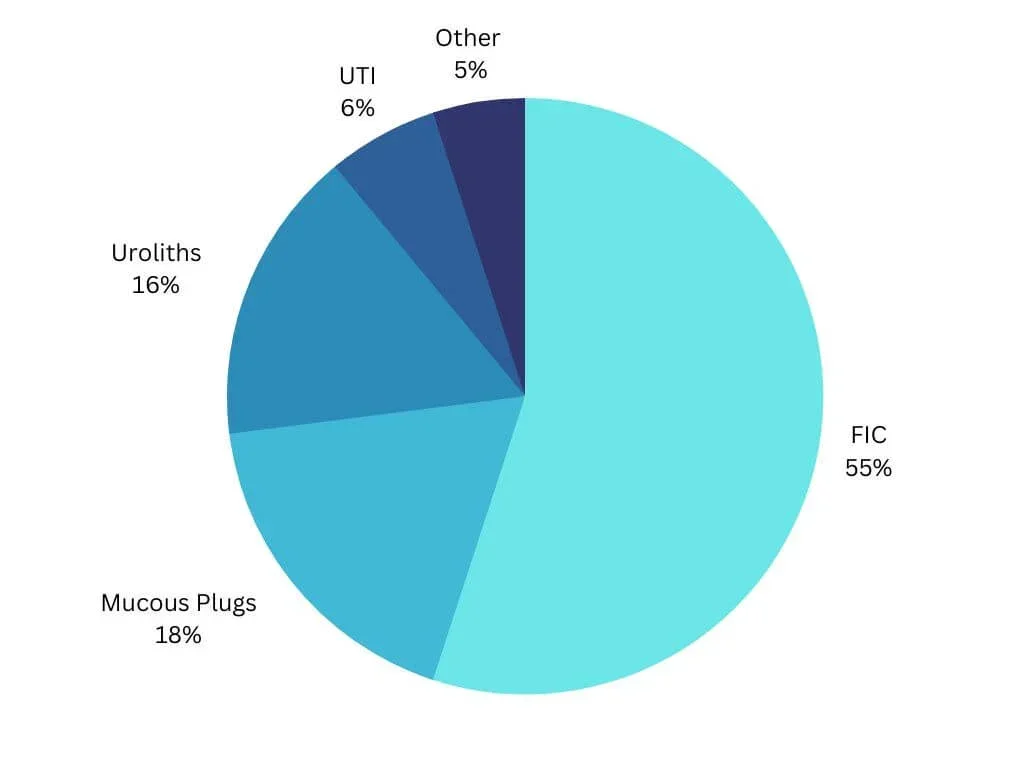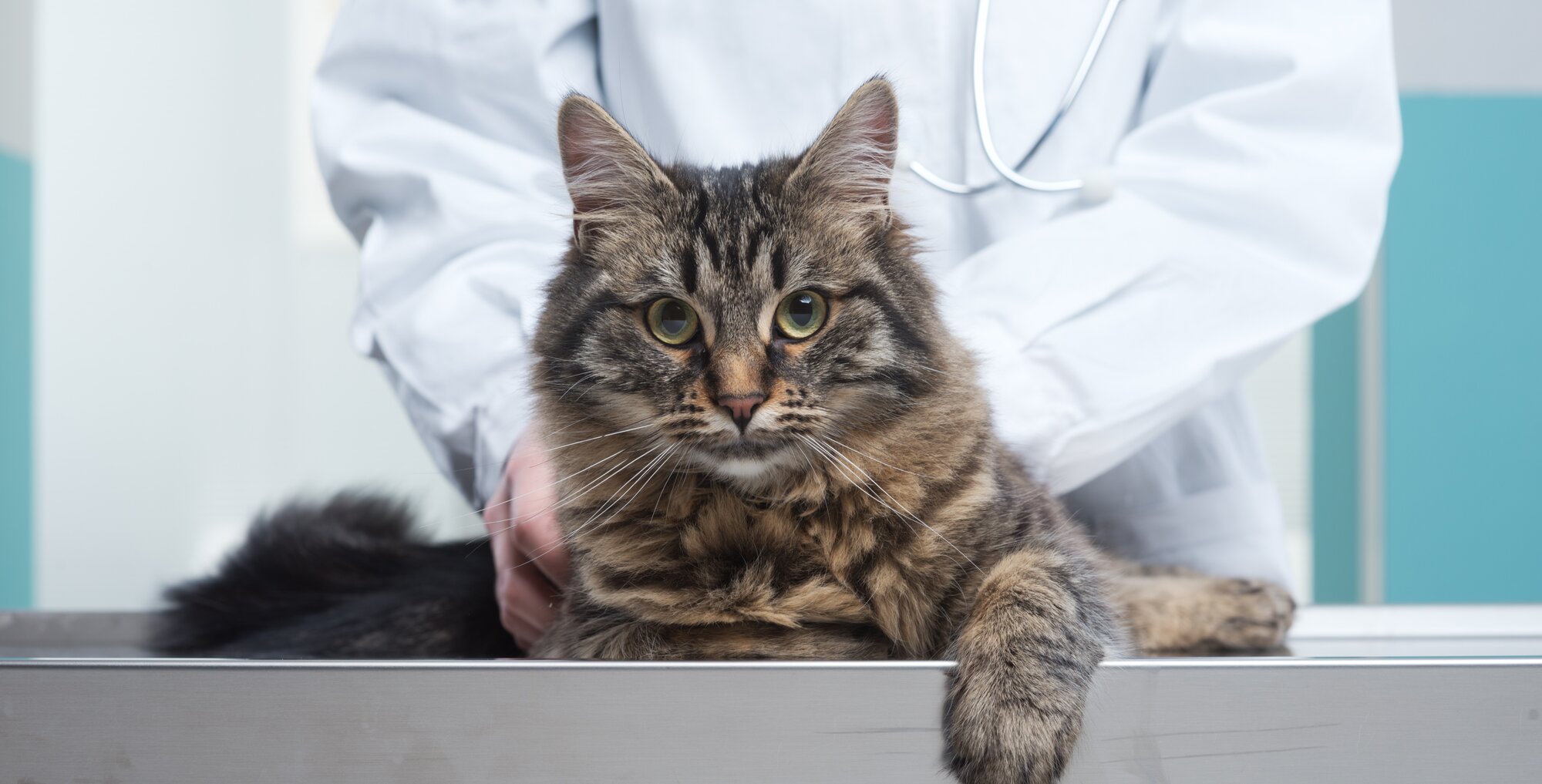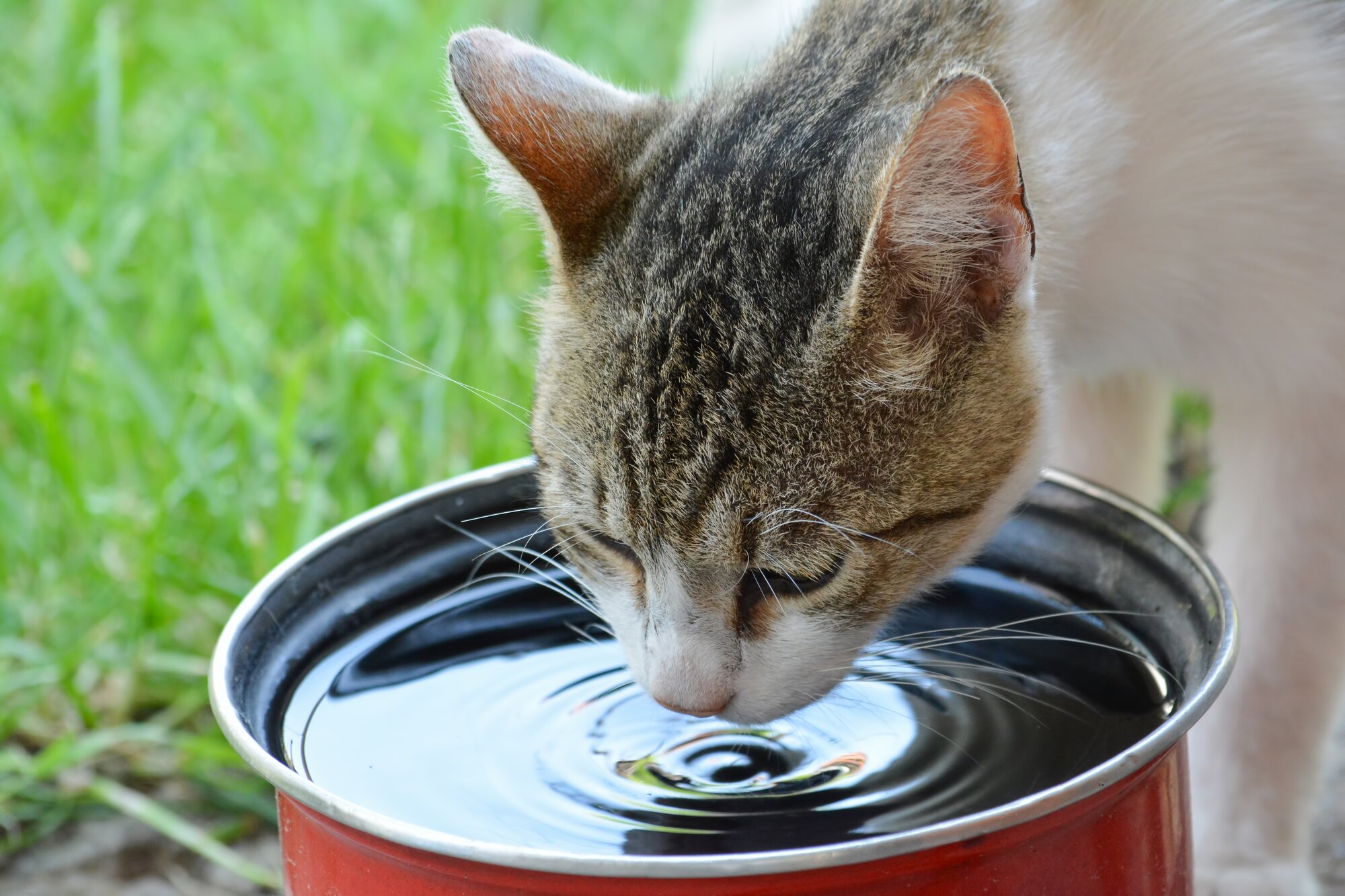Last Updated: 08/10/2025
Feline Lower Urinary Tract Disease (FLUTD) in Cats
Learn about FLUTD in cats - its causes, symptoms, and treatment options, including how diet and stress management can support your cat’s urinary health.
Author: Dr Belinda Stancombe BVSc (Hons)
Reading Time: 10 minutes - short read
Urinary related issues are one of the most common reasons that cats will present at the veterinarian. In fact, in some cases urinary issues in cats can be a medical emergency!
Unwanted toileting behaviour such as urinating outside the litter box is one of the most common complaints of pet parents. While this can be a frustrating issue for owners, for cats it is often an indication of an underlying medical condition.
Feline Lower Urinary Tract Disease (FLUTD) is the main complex of issues that affects the urinary system in cats. Understanding the risk factors behind the development of FLUTD and ways to help prevent it, can reduce your cats risk of developing urinary issues and help prevent unwanted toileting behaviours.
What is Feline Lower Urinary Tract Disease (FLUTD)?

The urinary system consists of the kidneys, ureters, bladder and urethra.
The kidneys are responsible for cleaning the blood of toxins and removing excess waste and fluid in the form of urine. This urine travels down the ureters and is stored in the bladder where it is eventually excreted and passed through the urethra when the cat urinates.
Urinary disease refers to any medical condition that affects an area of the urinary system, from the kidneys to the urethra.
Feline Lower Urinary Tract Disease (FLUTD), as the name implies is a group of medical conditions that affect the lower areas of the urinary system, of the bladder and urethra. Feline Lower Urinary Tract Disease (FLUTD) is not a single issue, but rather a group of medical conditions.
Signs of FLUTD in cats
Common signs of FLUTD in cats are:
- Urinating outside the litter box
- Straining to urinate
- Blood tinged urine
- Frequent urination
- Vocalising when urinating
- Passing small amounts of urine
- Licking genitals
What causes FLUTD?

Urinary Tract Infection (UTI)
A urinary tract infection is an infection present in the urinary system due to the presence of bacteria. Although a regularly diagnosed condition in dogs and humans, a UTI in cats is uncommon and often only occurs secondary to another underlying condition such as a concurrent disease (eg hyperthyroidism, diabetes, kidney failure) or suppression of the immune system. UTI's are most commonly seen in the Persian breed, females and older aged cats.
Uroliths - Crystals and Stones
Minerals are naturally present and excreted in the urine. These minerals can clump together causing struvite crystals or calcium oxalate stones to form in the bladder, leading to irritation of the bladder lining, bleeding, mucous formation or plugs.
Mucous Plug
A mucous plug is a solid mass of mucous, crystals and cellular debris causes by chronic irritation, inflammation or infection of the bladder.
Urethral Obstruction
A urethral obstruction or blockage occurs when the urethra becomes completely blocked by uroliths (crystals or stones) or a mucous plug (formed due to inflammation of the bladder wall), and the cat is unable to pass urine. Urinary blockages are more common in male cats due to their anatomy and the narrowing of the urethra. A urethral blockage is a medical emergency and requires immediate treatment.
Feline Idiopathic Cystitis (FIC)
In cases where no underlying cause for FLUTD can be found, then a diagnosis of FIC may be made. FIC refers to generalised inflammation of the bladder due to an unknown cause.
Although the exact mechanism is not well understood, stress is often a factor in cats that suffer from FIC. When some cats experience stress, the protective lining of the bladder wall is weakened, predisposing them to signs of cystitis which may progress to the secondary development of uroliths, UTIs and urethral obstruction.
Risk Factors of FIC include:
- Stress
- Young to Middle Aged
- Male
- Desexed
- Overweight
- Indoor only
- Multi-cat household
- Dry food only diet
- Low water intake
Other - Neoplasia, Anatomical abnormalities
In older cats, tumours can develop in the bladder, leading to secondary FLUTD signs. In young cats, persistent urinary issues can be present when a congenital abnormality has occurred and the cat has been born with an abnormal urinary system.
How is FLUTD diagnosed?

For cats showing clinical signs of FLUTD, such as urinating inappropriately, a check up with a veterinarian is recommended. The veterinarian will ask questions to gather an accurate history and perform a thorough clinical examination. Further tests such as a urinalysis, urine culture, blood test, xray or ultrasound may be required to identify an underlying cause. Once the cause has been found then a treatment plan can be formulated.
WARNING
Urethral blockage is a medical emergency. Any cat unable to urinate should be seen by a veterinarian immediately! Not only is this condition incredibly painful but failure to provide immediate treatment can lead to more complicated conditions including bladder rupture, kidney failure or even death.
How is FLUTD treated and managed?
The treatment for FLUTD is dependent on the diagnosed underlying cause. If a urethral obstruction is identified, then emergency surgery is required to unblock the urethra and establish urination before the cat suffers permanent and irreversible damage. Complications of urethral obstruction can include bladder rupture, kidney failure and even death!
If uroliths are identified then a Veterinary Prescription Urinary Diet may be recommended to dissolve them or in some cases surgical removal may be required. In most cases, it is recommended that if uroliths have been found that they continue on a prescription diet for life to prevent reoccurence.
If a UTI or Cystitis is diagnosed then antibiotics and/ or anti-inflammatories may be prescribed.
In the case of cats diagnosed with FIC, minimising stress is an important part of treatment through the use of calming supplements, pheromones, therapeutic diets or prescription medication.
Prevention of FLUTD in cats

Once the underlying conditions have been diagnosed and treated then the focus can shift to preventing recurrence of FLUTD. Studies have shown that if no changes are made then 40-50% of cats that have suffered from FLUTD will have a recurrence within 1 year of diagnosis.
1. Reduce Stress
Some common causes of stress in cats include moving house, new visitors, introducing a new pet, a trip to the vet or groomer, coping with the loss of family member or pet, new furniture or even just rearranging your furniture.
If there is a pet or family member (such as a child) that a cat doesn't like, providing them with adequate hiding areas, can help them feel that they have somewhere safe to escape to. Things like cat trees, hidey-hole beds, and high shelf beds such as window hammocks and beds can all help cat's feel safe.
Natural anti anxiety products such as pheromones, supplements and therapeutic diets can help reduce daily anxiety in cats, and can also be introduced in the lead up to a stressful event.
Looking for more information on minimising anxiety in your cat? Read our veterinary written article How To Reduce Stress and Anxiety in Cats.
2. Provide Enough Litter Trays
It is important that enough litter trays are provided throughout the house, especially in a multi-cat households. The general rule is to provide the same number of litter trays as cats, plus one. For example in a 2 cat household, 3 litter trays would be recommended.
Cats can be incredibly fussy about all aspects of toileting including the type of litter tray, litter brand, cleanliness of litter tray and litter tray locations. Any variation in these may lead to them avoiding using the litter tray, which can increase the risk of FLUTD.
Ensure that the litter tray is kept clean, placed in a quiet place and that multiple location options are available to cater to all cat preferences. Investing in a self cleaning litter tray can be a great way to always keep the toileting area clean and fresh! Ensure that an enzyme-based cleaner is used to clean any accidents, to decrease the chance of inappropriate toileting again in the same area in the future.
Looking for more information? Read our veterinary written article Complete Guide To Cat Litter.
3. Feed a Premium Diet
For cats that have not suffered from urinary issues before, feeding a premium diet can help prevent issues from developing. Premium brand cat food such as Hill's Science Diet, Royal Canin or Advance have ideal levels of magnesium, phosphorus, protein and calcium to help avoid the formation of crystals or stones in the urine. There are even a range of Premium Urinary Care Diets available that have been specially formulated to maintain urinary health in adult cats.
Cats that have suffered from FLUTD in the past, may require a Veterinary Prescription Urinary Diet for life. These diets are designed with the right balance of nutrients to promote a healthy bladder and contain ingredients to control urine pH, minerals and protein to decrease, and in some cases, even dissolve urolith formation. It is for this reason that these diets are recommended to be fed as sole diets as combining with different formulations can throw out this balance and reduce their efficacy. This also includes combining different brands of prescription urinary diets together.
Looking for more information on Premium Diets? Read our veterinary written article Supermarket vs Premium Food: A Complete Comparison.
Please note that the diets above are only suitable if your vet has not recommended a prescription urinary diet for your cat. These over-the-counter, non-prescription diets are not designed to manage or treat urinary issues in cats with a history of FLUTD.
4. Increase Water Intake
It can be hard to encourage your cat to drink more water. Many cats prefer fresh running water so providing your cat with a water fountain can be a great way to encourage them to drink. Wet food is high in water, so feeding your cat a diet with the addition of wet food or a broth or cat meal topper is a great way to boost their daily water intake.
Pro Plan Hydra Care Supplement is a tasty liquid enriched with important nutrients, formulated to increase water intake to keep your cat hydrated and help increase urine dilution. It makes a tasty addition to your cats regular meal and is a great way to entice fussy cats.
Looking for more information? Read our veterinary written article on how to Increase Your Cat's Water Intake.
5. Weight Management
Overweight cats are at a greater risk of developing urinary issues. As with humans, the best way to manage weight in cats is through diet and exercise.
Cats that are overweight may benefit from a veterinary prescription weight loss diet which is specially formulated to help manage calories and promote weight loss. Hills Science Diet even have a diet available that combines urinary and weight care with the addition of stress management in the one formulation, Hills Prescription Metabolic Plus Urinary Stress Dry Food and Hills Prescription Metabolic Plus Urinary Stress Wet Food.
Play is one of the best ways to get a cat moving and encourage weight loss. Many people assume that an overweight cat is too lazy to play. Often they just need more interactive toys to peak their interest, or a particular type of toy such as one with feathers or a laser. Changing toys regularly can help keep things interesting and encourage play.
For more information, read our veterinary written article on Games to Play with Your Cat.
FAQs
FLUTD can be a distressing and painful condition for your cat, but understanding its causes is the first step towards prevention. By focusing on proactive management- including minimising stress, feeding a high-quality urinary care diet, and encouraging water intake - you can significantly support your cat's long-term urinary health.
Always be vigilant for the signs of a urinary issue, and remember that any difficulty urinating is an emergency that requires immediate veterinary attention. Your vet is your best partner in keeping your feline friend happy and healthy.
Articles recommended for you
Our vet authored guide to the benefits of feeding your dog fresh food plus tips and advice for introducing it into their regular menu.
See our guide to protecting your pet from parasites from our vet team.
Thinking of getting a fish? Check out our guide for setting up a tank and home care tips!
Looking to understand horse feeds better? This comprehensive guide covers feeding recommendations for horses of all ages and disciplines.
Does your pet suffer from anxiety? Check out our Vet-guide for treatment options to help your pet.
History
Our experts continually monitor the health and wellness space and we update our articles when new information becomes available.
Wed 8 Oct 2025
Edited by Dr Gillian Hill BVSc (Hons)Dr Belinda Stancombe BVSc (Hons)
Veterinarian
Dr Belinda graduated from The University of Queensland in 2009 and has worked as a Small Animal Veterinarian for over 10 years in South East Queensland. She also has experience as a telehealh consultant, providing veterinary advice for online customers.She has a special interest in animal behaviour, preventative health, the human-animal bond and internal medicine. Outside of work hours she is closely affiliated with a kitten rescue and is also a devoted carer of orphaned rescue kittens.

